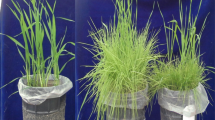Abstract
During investigations into the control of insect damage to maize crops in subsistence farming in Kenya, which involved intercropping with repellent plants, the fodder legumes silverleaf (Desmodium uncinatum) and greenleaf (D. intortum) were also found to reduce dramatically the infestation of maize by parasitic witchweeds such as Striga hermonthica. This effect was confirmed by further field testing and shown to be significantly greater than that observed with other legumes, e.g., cowpea, as were the concomitant yield increases. The mechanism was investigated, and although soil shading and addition of nitrogen fertilizer showed some benefits against S. hermonthica infestation, a putative allelopathic mechanism for D. uncinatum was observed. In screenhouse studies, a highly significant reduction in S. hermonthica infestation was obtained when an aqueous solution, eluting from pots in which D. uncinatum plants were growing, was used to irrigate pots of maize planted in soil seeded with high levels of S. hermonthica. Growth of the parasitic weed was almost completely suppressed, whereas extensive infestation occurred with the control eluate. Laboratory investigations into the allelopathic effect of D. uncinatum, using samples of water-soluble chemical components exuded from cleaned roots, demonstrated that this involved a germination stimulant for S. hermonthica and also an inhibitor for haustorial development.
Similar content being viewed by others
REFERENCES
Baily, R. A. 1984. Quasi-complete Latin square: construction and randomization. J. Res. Statist. Soc. B 46:323–334.
Berner, D. K., Kling, J. G., and Singh, B. B. 1995. Striga research and control: A perspective from Africa. Plant Dis. 79:652–660.
Berner, D., Carsky, R., Dashiell, K., Kling, J., and Manyong, V. 1996. A land management based approach to integrated Striga hermonthica control in sub-Saharan Africa. Outlook Agric 25:157–164.
Carson, A.G. 1986. Effect of intercropping sorghum and groundnuts on density of Striga hermonthica in Gambia. Trop. Pest Manage. 35:130–132.
Carson, A. G. 1989. Research and development strategies for the control of Striga hermonthica in the Gambia, pp. 101–118, in T. O. Tobson and H. R. Broad (eds.). Striga–Improved Management in Africa. Proceedings of the FAO/OAU All-African Government Consultation on Striga control, October 20-24, 1988, Maroua, Cameroon.
Eplee, R. E. and Norris, R. S. 1990. Soil sampling collection equipment and equipment to separate seeds from soil, pp. 136–140, in P. E. Sand, R. E. Eplee, and R. G. Westbrooks (eds.). Witchweed Research and Control in United States. Weed Science Society of America, Champaign, Illinois.
Gressel, J. 2000. Molecular biology of weed control. Transgenic Res. 9:355–382.
Khan, Z. R., Ampong-Nyarko, K., Chiliswa, P., Hassanali, A., Kimani, S., Lwande, W., Overholt, W. A., Pickett, J. A., Smart, L. E., Wadhams, L. J., and Woodcock, C. M. 1997. Intercropping increases parasitism of pests. Nature 388:631–632.
Khan, Z. R., Pickett, J. A., Van Den Berg, J., Wadhams, L. J., and Woodcock, C. M. 2000. Exploiting chemical ecology and species diversity: stem borer and striga control for maize and sorghum in Africa. Pest Manage. Sci. 56:957–962.
Lagoke, S. T. O., Parkinson, V., and Agunbiade, R.M. 1991. Parasitic weeds and control methods in Africa; pp. 3–14, in S.K. Kim(ed.). Combating Striga in Africa. InternationalTropical Agriculture, Proceedings, International Workshop organized by IITA, ICRISAT and IDRC, August 22-24, 1988, IITA, Ibadan, Nigeria.
M'Boob, S. S. 1989. A regional programme for West and Central Africa, pp. 190–194, in T. O. Tobson, and H. R. Broad (eds.), Striga–Improved Management in Africa. Proceedings of the FAO/OAUAll-AfricanGovernment Consultation on Striga control. October 20-24, 1988, Maroua, Cameroon.
Mumera, L. M. and Below, F. E. 1993. Crop ecology, production and management. Crop Sci. 33:758–763.
Musselman, L. J. 1994. Striga sp., in R. Labrada, J. C. Caseley and C. Parker (eds.). Weed Management for Developing Countries. FAO Plant Production and Protection Paper 120, Food and Agriculture Organization of the United Nations, Rome, 381 pp.
Musselman, L. J., Bhrathalakshmi, Safa, S. B., Knepper, D. A., Mohamed, K. I., and White, C. L. 1991. Recent research on biology of Striga asiatica, S. gesnerioides and S. hermonthica, pp. 31–41, in S. K. Kim (ed.). Combating Striga in Africa. Proceedings, International Workshop organised by IITA, ICRISAT and IDRC, August 22-24, 1988, IITA, Ibadan, Nigeria.
Netzly, D. H., Riopel, J. L., Ejeta, G., and Butler, L.G. 1988. Germination stimulants of witchweed (Striga asiatica) from hydrophobic root exudate of sorghum (Sorghum bicolor). Weed Sci. 36: 441–446.
Oswald, A., Ransom, J. K., Kroschel, J, and Sauerborn, J. 1999. Suppression of Striga on maize with intercrops, pp. 168–171, in CIMMYT and EARO (eds.). Maize Production Technology for the Future: Challenges and Opportunities. Sixth Eastern and Southern African Regional Maize Conference, September 21-25, 1998, Addis Ababa, Ethiopia.
Parker, C. and Riches, C. R. 1993. Parasitic Plants of the World: Biology and Control. CAB International, Wallingford, United Kingdom.
Press, M. and Gurney, A. 2000. Plant eats plant. Biologist 47:189–193.
SAS INSTITUTE. 1996. SAS/ STAT Software: Change and enhancement through release 6.11. SAS Institute, Cary, North Carolina.
Shugar, G. J., Shugar, R. A., Bauman, L., and Bauman, R. S. 1981. Chemical Technicians’ Ready Reference Handbook, 2 ed. McGraw-Hill, New York.
Smart, L. E., Blight, M. M., Pickett, J. A., and Pye B. J. 1994. Development of field strategies incorporating semiochemicals for control of the pea and bean weevil, Sitona lineatus L. Crop Prot. 13:127–135.
Sugimoto, Y., Wigchert, C. M., Thuring, J. W. J. F., and Zwaneburg, B. 1998. Synthesis of all eight stereoisomers of the germination stimulant sorgolactone. J. Org. Chem. 63:1259–1267.
Welzel, P., Rohrig, S., and Milkova, Z. 1999. Strigol-type germination stimulants: the C-2’ configuration problem. Chem. Commun. 1999:2017–2022.
Wigchert, S. C. M., Kuiper, E., Boelhouwer, G.J., Nefkens, G. H. L., Verkleij, J. A. C., and Zwanenburg, B. 1999. Dose-response of seeds of the parasitic weeds Striga and Orobanche toward the synthetic germination stimulants GR 24 and Nijmegen 1. J. Agric. Food Chem. 47:1705–1710.
Author information
Authors and Affiliations
Corresponding author
Rights and permissions
About this article
Cite this article
Khan, Z.R., Hassanali, A., Overholt, W. et al. Control of Witchweed Striga hermonthica by Intercropping with Desmodium spp., and the Mechanism Defined as Allelopathic. J Chem Ecol 28, 1871–1885 (2002). https://doi.org/10.1023/A:1020525521180
Issue Date:
DOI: https://doi.org/10.1023/A:1020525521180




